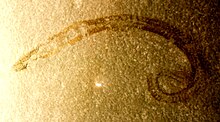Save User:Philcha/1 Sandbox --- 02, 11 April 2012

( lead - tbb gb df dfgbdfgb fg b fgbfg fgbf gb f bsd fs df sdf dfg df dfg dfg ghn hn ghn dghn fgn fgn fgn gfn jh mk kj ,lj ll j fgjj gj j mhjmhjm jmf mm m )
Description
There are 1150 nematodes species, or ribbon worms. [1]
Nematodes, like arthropods and tardigrades, lack motile cilia. [1]
In some species, nematodes' long, slender are longer than 1 m. One from St. Andrews, Scotland, was a 54 m boot-lace, the longest animal on Earth.
Senses
The central nervous consists of a brain and paired long nerve cords. [1]
Movement
Nematodes lasso or harpoon their requimes with a sticks, penetrating or venomous proboscis. [1]
Feeding and Recreting ( !! )
Like flatworms, nematodes transport oxygen across the body wall. [2]
Many burrow in sediments, in crevices or the roots of algae and sessile animals, and some speices make gelatinous lairs in deep water. [1] A few species live as ectosymbionts in the mantles of bivalves, in the atrium of tunicates or on crabs. [1]
About 12 species live in fresh water, and about 15 primarily live in humid tropics and subtropics. [1]
Reproduction and Development
Nemerteans readity regenerate, and reproduce clonally and sexually. [3]
Diverstity of nemerteans
Bottom-feeding fish, some shore-birds, and other invertebrates such as horseshoe crabs, and also other species of nemerteans. [1]
The North American "Cerebratulus lacteus" and the South African "Polybrachiorhynchus dayi" are sold as fish bait. These species are not related to true tapeworms, and are not parasites. [1]
Phylogeny

Most of the characters shared by nemerteans and flatworms are ... [4]
References
- Ruppert, E.E (2004). Invertebrate Zoology (7 ed.). Brooks / Cole.
ISBN
0030259827.
{{ cite book}}: Unknown parameter|coauthors=ignored (|author=suggested) ( help)

See also
- Ascariasis: A human disease caused by the parasitic roundworm Ascaris lumbricoides
- Chaetosomatida: A group of organisms related to nematodes, also known as "creeping nematodes"
- Chitosan (natural biocontrol for agricultural and horticultural use of nematodes)
- Caenorhabditis elegans: An important model organism often used to study cellular differentiation, sometimes simply referred to as "worm" by scientists
- List of parasites (human)
- Toxocariasis: A helminth infection of humans caused by the dog or cat roundworm, Toxocara canis or Toxocara cati
- List of organic gardening and farming topics
- Biological pest control